August 12, 2022
Air Date: August 12, 2022
FULL SHOW
SEGMENTS

Democrats Deliver on Climate
View the page for this story
The United States Congress has passed historic climate legislation with the enactment of the 2022 budget reconciliation measure called the Inflation Reduction Act. This first serious federal legislation to address the climate crisis includes about $400 billion to address climate and clean energy over the next decade, as well as major tax reforms and mandated consumer cost cuts for health care. With help from Aaron Bernstein MD of Harvard and Car Talk blogger Jim Motavalli, Hosts Steve Curwood and Jenni Doering analyze the new law, including details about expanded electric vehicle incentives. (09:19)

Medical Plastic Linked to Breast Cancer Relapse
View the page for this story
Breast cancer is the leading cause of cancer death among women worldwide, and endocrine disrupting chemicals are partly to blame. One such chemical is DEHP, a phthalate chemical commonly used in plastic hospital intravenous bags and medical tubing, and studies have shown that it’s interfering with breast cancer treatment and augmenting the odds of relapse. Pete Myers, the founder and chief scientist of Environmental Health Sciences, talks with Host Steve Curwood about the study findings and how to protect patients from harm caused by endocrine disrupting chemicals. (11:50)
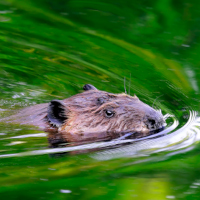
Beavers Move Into the Arctic
View the page for this story
The Arctic is warming roughly twice as fast as much of the globe and some species are already moving toward the poles in search of new habitat. And as beavers move north into the Arctic these big rodents known as “ecosystem engineers” are bringing big changes to the landscape. Ben Goldfarb is the author of Eager: the Surprising, Secret Life of Beavers and Why They Matter and joins Living on Earth’s Jenni Doering to discuss the concerns and benefits of beavers in the Arctic. (08:40)
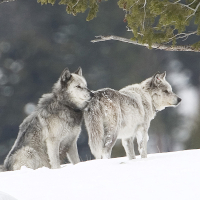
The Reign of Wolf 21
/ Jenni DoeringView the page for this story
Wolf expert Rick McIntyre’s 2020 book "The Reign of Wolf 21" is the true love story of an alpha pair who lead their Yellowstone pack with grace, courage, and an unbreakable bond. Living on Earth’s Jenni Doering has the story of these remarkable wolves’ lives and what they can teach us about love, loyalty, and leadership. (16:46)
Show Credits and Funders
Show Transcript
220812 Transcript
Hosts: Steve Curwood & Jenni Doering
Guests: Aaron Bernstein, Jim Motavalli, Pete Myers, Ben Goldfarb, Rick McIntyre
[THEME]
CURWOOD: From PRX this is Living on Earth
(THEME)
I’m Steve Curwood
DOERING: And I’m Jenni Doering. America finally has national climate legislation.
BERNSTEIN: It is a watershed moment that we should all look back on and really be proud particularly at this time when everything seems so fractured, and difficult and headed potentially in the wrong direction. This this is an extraordinary step forward.
CURWOOD: Also, the remarkable life and love of a wolf who led a pack in Yellowstone.
MCINTYRE: He was, um… I think many people would agree that he was probably the greatest wolf that has ever been known by a human being. So just to be able to see him every day for year after year was just a huge privilege on my part.
CURWOOD: That and more this week on Living on Earth – Stick Around!
[NEWSBREAK MUSIC: Boards Of Canada “Zoetrope” from “In A Beautiful Place Out In The Country” (Warp Records 2000)]
[THEME]
Democrats Deliver on Climate
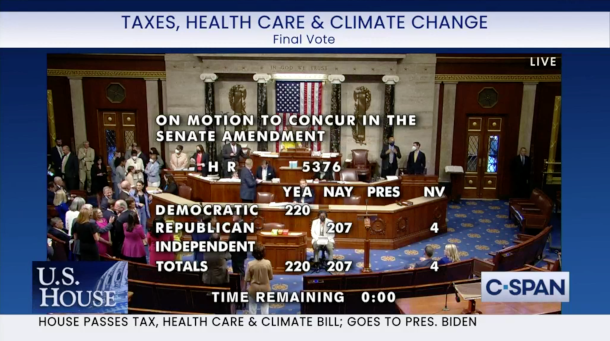
The U.S. House of Representatives passed the Inflation Reduction Act of 2022 on August 12. All Democratic representatives voted yes to pass, while no Republican representatives did. (Screenshot: C-SPAN)
CURWOOD: From PRX and the Jennifer and Ted Stanley Studios at the University of Massachusetts Boston, this is Living on Earth. I’m Steve Curwood.
DOERING: And I’m Jenni Doering. Well Steve, more than 30 years after you first learned about global warming and started this show, Congress has finally passed serious legislation to reduce emissions.
CURWOOD: Yeah, it’s been a long wait to celebrate if you care about the climate. When Bill Clinton and Al Gore came into office in 1993, they couldn’t get a BTU tax through Congress. And then in 1997 the Senate made it clear it wouldn’t ratify the Kyoto Protocol.
DOERING: Yeah, and in 2009 the Senate filibuster killed the Waxman-Markey cap and trade bill that had passed the House. And then President Obama’s efforts with the clean power plan rules first got repealed by President Trump and then recently scuppered when the Supreme Court set almost impossible hurdles for such regulations.
CURWOOD: But now we have the Inflation Reduction Act, a clever marketing title I must say, and it’s a budget reconciliation measure that restructures some taxes, reduces some health costs, and puts close to 400 billion dollars towards climate action over the next decade. It’s a big deal, and it’s forecast to reduce US emissions by 40 percent over 2005 levels by the end of the decade, close to the target of 50 percent President Biden announced on his first Earth Day in office, so while there is more work to be done now that work will seriously begin.

The Inflation Reduction Act includes funding opportunities for schools to operate electric buses and improve air quality in buildings. (Photo: Province of British Columbia, Flickr, CC BY-NC-ND 2.0)
DOERING: Yeah and Steve, how much will this new law actually reduce inflation?
CURWOOD: Interesting you should ask. Former Treasury secretary Lawrence Summers of Harvard says the Act’s provisions that reduce deficits by taxing more of the rich and cut health and energy expenses are in fact all anti-inflationary. Now Larry Summers declined to confirm he had discussed the bill with deficit hawk Joe Manchin, the Democratic Senator from West Virginia, saying in published reports their talks over the past year were private. But Joe Manchin’s holdout for deficit reductions apparently worked and calling the new law the Inflation Reduction Act is not just marketing hype.
DOERING: Oh Interesting. So Steve, let’s take a look now at some of the green details of this measure. There are tax credits for clean manufacturing and renewable energy, including a decade of certainty for tax credits for residential solar. There’s a green bank to attract private dollars for clean technologies and stiff penalties for methane leaks from wells and pipelines. We won’t list all the details now, but you can find more on the Living on Earth website at loe dot org. And although there’s a whole separate section of the Inflation Reduction Act for healthcare, you could say the climate measures themselves are key for health too. So we called up Ari Bernstein, a pediatrician and Interim Director of the Center for Climate, Health, and the Global Environment at the Harvard T.H. Chan School of Public Health to get his take.
BERNSTEIN: I've been working on climate and health for over 20 years. This is by far and away the most important piece of legislation to address the health effects of fossil fuel use and climate change, by a longshot. It doesn't mean that we can now step back and say, we've got this. There's a lot of work to make sure that this legislation gets used in ways that really do promote health and equity and result in the kinds of emissions reductions that we need.

Aaron Bernstein MD is the Interim Director of the Center for Climate, Health, and the Global Environment at the Harvard T.H. Chan School of Public Health, a pediatrician at Boston Children's Hospital, and an Assistant Professor of Pediatrics at Harvard Medical School. (Photo: Courtesy of Harvard T H Chan School for Public Health)
CURWOOD: And the climate crisis is certainly bad news for our health, I mean just recently we’ve seen so much death and illness from extreme heat, fires, storms, and floods. And Dr. Bernstein’s group has shown that air pollution from burning fossil fuels leads to some 300,000 excess deaths every year in this country.
BERNSTEIN: We know from prior work on transportation and on energy systems, that even modest reductions well below what this bill is likely to produce would save, you know, billions and billions of dollars in health costs, avoided deaths. And I think it does depend in some ways on how these funds actually wind up getting used, you can save a lot of carbon without actually reducing air pollution very much. So you know, there's some amount of let's let's wait and see. But, you know, there's certainly a good prospect here of dramatically improving health and particularly addressing health disparities, because so much of the pollution gets emitted in communities that have been historically polluted the most.
DOERING: Now Steve this bill puts around $60 billion towards remedying some of those environmental injustices.
CURWOOD: And Jenni there’s a lot of money for greening transportation, which is a big culprit for the air pollution that hits disadvantaged communities. And overall transportation is the biggest single source of greenhouse gas emissions in the U.S. these days, something like 27%. But if much of the power for electric cars, trucks, and buses keeps coming from coal and gas, it won’t help the climate that much. That’s why a broader shift to clean energy is so important. So now let’s talk about electric cars because that’s easy for folks to relate to.
DOERING: Yeah, sales have been growing but still, only 6 percent of new light vehicles sold last year were electric. After all, EV’s are pricey, about $10k more than gas powered vehicles. So now, the act creates a $35 billion pool for clean fuel and vehicle tax credits, and eligible consumers will save $7500 on any new electric car assembled in America with qualified materials and as much as $4000 for a used one.
CURWOOD: And when do they get that money back, after filing their taxes?

The Inflation Reduction Act boosts fossil fuels, reinstating old oil and gas auctions that the Biden Administration had tried to cancel as well as requiring new future auctions. It also requires the auction of millions of acres of oil and gas leases before the same can be done for wind and solar farms. (Photo: Glenn Euloth, Flickr, CC BY-NC-ND 2.0)
DOERING: Well, that’s how the rebate used to work but now it can be applied at the “point of sale”.
CURWOOD: Oh, so you get to save that money up front?
DOERING: Right. And as Jim Motavalli, CarTalk blogger and green car writer told us, there are some other restrictions on which vehicles qualify.
MOTAVALLI: It puts a cap on the MSRP, or the Manufacturer's Suggested Retail Price on the cars you're buying, you can't use it for really high-end luxury SUVs. And actually, I've recently driven cars like the Mercedes EQS that are well outside this, you know, the purchase price well over $100,000. But for cars, you'll only be able to get vehicles that are $55,000. And below, and for SUVs and trucks 80,000 around in there and below. So, it's not looking to subsidize high end luxury cars for the rich, which is probably a good thing to have in there.
DOERING: Now there’s already a dearth of the computer chips automakers need and the lithium industry forecasts that essential mineral for batteries is going to be in short supply until 2030. But the good news is that in the long term, Jim Motavalli sees a bigger shift towards a more circular supply chain for electric vehicles.

The Inflation Reduction Act provides a tax credit up to $7,500 for buyers of new all-electric cars and hybrid plug-ins as well as creates a separate tax credit worth a maximum $4,000 for used electric. (Photo: City of St. Pete, Flickr, CC BY-ND 2.0)
MOTAVALLI: There's a whole lot of startup companies that are going to be producing particularly lithium in the United States, but also working on recycling some of those materials, so they wouldn't have to be sourced as raw mined materials but could be acquired from existing cars going into junkyards. So that's a big movement now. And I think it's going to be very successful. I think it's, it's something like 95 to 98% of EV minerals and metals can be actually reclaimed from those batteries.
DOERING: Full disclosure, I drive an electric car, and aside from not having to worry about inflated gas prices, they are a lot of fun to drive!
CURWOOD: Yeah! And, this historic legislation has put some pep in the step of those like Dr. Bernstein who are troubled by so much of our current state of affairs.
The Inflation Reduction Act will reduce the deficit by $300 billion.
— President Biden (@POTUS) August 6, 2022
And we’ll do it without raising taxes a penny on those making less than $400,000 a year.
BERNSTEIN: It is a watershed moment that we should all look back on and really be proud particularly at this time when everything seems so fractured, and difficult and headed potentially in the wrong direction. This is an extraordinary step forward.
DOERING: Steve, I was honestly starting to lose hope that any kind of climate legislation could pass through Congress. Just seemed like there was just no way to get around the gridlock in Washington, especially on climate change, given the influence of the fossil fuel industry.
CURWOOD: But recently several key measures have passed, from microchip manufacturing support to medical relief for veterans and to lowered drug prices as part of the momentous climate bill. You know, some fifty years ago, President Joe Biden first went to Capitol Hill, about 35 years ago House Speaker Nancy Pelosi first went there and more than 40 years ago Senate Majority leader Chuck Schumer first came to Congress. And that team called on all that experience and demonstrated the art of compromise in the public interest is not dead.
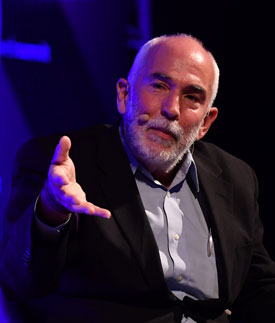
Jim Motavalli is a freelance environmental journalist and blogger for NPR’s Car Talk (Photo: Seb Daly, Web Summit, Wikimedia Commons, CC BY 2.0)
DOERING: Yeah, the whole Democratic congressional caucus signed onto the measure, from the most moderate to the most progressive, despite criticism from some activists that this bill doesn’t do enough for environmental justice and concedes too much to the fossil fuel industry. That industry has the opposite complaint. The American Petroleum Institute says the measure “falls short in addressing America’s energy needs.”
CURWOOD: Well, Jenni that’s the thing about compromise, nobody gets everything they want. But that’s just what it sometimes takes to get things done. Just a few weeks ago some pundits were sniping at President Biden and his low approval ratings to suggest he should quit after one term. But already after less than two years, with tight margins in the House and a razor thin majority in the Senate President Biden has led the Democrats and the nation to move forward on a broad front, including finally confronting our gravest existential threat. Low polls today perhaps for Joe Biden, but likely high marks in the annals of history.
Related links:
- Read the Inflation Reduction Act
- Watch Rep. Kathy Castor and other House Democrats give remarks on the Inflation Reduction Act
- Learn more about Pediatrician Aaron Bernstein
- Visit Jim Motavalli’s Website
- Gov Tech | “What Does the Inflation Reduction Act Mean for K-12 Schools?”
- Check out Living on Earth’s Interview with Aaron Bernstein on how fossil fuels affect human health
- Energy Innovation Policy & Technology LLC | “Modeling the Inflation Reduction Act Using the Energy Policy Simulator”
- Nerd Wallet | “What the Inflation Reduction Act Means for Green Energy and EV Stocks”
[MUSIC: Queen Under Pressure, David Bowie & Queen on Hot Space 1982]
DOERING: Coming up – how plastics in medical tubing can thwart chemotherapy.
That’s just ahead on Living on Earth. Stay tuned!
ANNOUNCER: Support for Living on Earth comes from Sailors for the Sea and Oceana. Helping boaters race clean, sail green, and protect the seas they love. More information @sailorsforthesea.org. Support also comes from Friends of Smeagull the Seagull and Smeagull’s Guide to Wildlife. It’s all about the wildlife right next door to you! That’s Smeagull, S - M - E - A - G - U - L - L, SmeagullGuide.org.
[MUSIC: Duke Ellington, “Very Special – Remastered” on Money Jungle, Blue Note Records]
Medical Plastic Linked to Breast Cancer Relapse

DEHP is a common phthalate found in medical devices that can interfere with the effectiveness of certain cancer treating drugs. (Photo: franchise opportunities, Flickr, CC BY 2.0)
DOERING: It’s Living on Earth I’m Jenni Doering
CURWOOD: And I’m Steve Curwood.
Breast cancer is the leading cause of cancer death among women worldwide, and except in the most affluent nations, death rates keep rising. In the US, where one out of eight women will get breast cancer in her lifetime, survival rates are better, thanks to screening and advanced chemotherapy and hormone treatments. But even in rich nations there are some breast cancer cases that are stubbornly resistant to chemo and hormone therapies, and thus are more likely to spread and recur. Now some government-funded researchers in Taiwan think they may know why.
They say a chemical commonly used in Intravenous bags and medical tubing may actually be making breast cancers worse. This chemical is a form of phthalates known by its initials, DEHP, and like many other phthalates, DEHP is an additive used to make plastics soft and pliable. Science already knows DEHP and other phthalates are linked to a variety of disorders from obesity to neurological development problems. And these chemicals enter our bodies in many ways including from a number of cosmetics and fast foods. And now with this recent finding, the health care system itself is implicated in the breast cancer epidemic, with evidence the plastic additive DEHP leached from IV bags and medical tubing can help breast cancer cells evade chemotherapy treatments. Joining us now is Pete Myers, founder and chief scientist of Environmental Health Sciences, a partner of EHN.org and dailyclimate.org. He joins me now. Welcome back to Living on Earth, Pete!
MYERS: Hi, it's great to be back, Steve, nice to see you.
CURWOOD: So, what did these researchers in Taiwan find out about DEHP and breast cancer?
MYERS: Well, their previous research, which was really interesting and suggestive, indicated that DEHP affects drug resistance, it reduces the effectiveness of certain drugs that are used to treat breast cancer. And what they did, with this paper, is they tried to figure out why that happened. This paper first confirmed their original findings. Patients with higher levels of DEHP don't respond as well to breast cancer treatment drugs, tamoxifen, and doxorubicin. Women who have had breast cancer in the past, are more likely to have it again, when they have higher levels of DEHP. But also, they found that women with higher levels are more likely to die. They have later stage tumors, the tumor sizes are larger. And this was all from the epidemiology, which was the first part of this study. They then did a series of cell and animal tests to figure out, what are the mechanisms that are causing that.
CURWOOD: And the answer is?
MYERS: Well, it's actually kind of clear, they used a classic breast tumor cell line series, and they showed that DEHP inhibits two drugs specifically, as I mentioned, tamoxifen and doxorubicin. And not only did they find that in the human breast tumor cell lines, they found that the same thing happens in the zebrafish model and a mouse model. What is causing this is that the DEHP turns on genes that produce enzymes that increase the degradation rate of the cancer treating chemicals. What this means is every time a person is being treated for breast cancer, and they're being infused with chemicals through IV tubes, what leaches out of the IV tubes is damaging the treatment program.
CURWOOD; So, it's as if the DEHP provides a defense for the cancer. Let me help you stay growing, Mr. Cancer or Ms. Cancer!
MYERS: Yeah, and one of the more interesting findings in these experiments was that DEHP turns on a gene, which geneticists call TFF-3, that actually speeds up the proliferation, invasion, metastasis, and drug resistance.
CURWOOD: Pete, this is somewhat, what's old is new again. I mean, some 30 years ago, Ana Soto at Tufts noticed that experimental breast cancer cells in test tubes were growing faster. She was puzzled by that till she realized, of course, it was related to the plastic.

Most medical tubing made from plastic like intravenous bags and tubing contain the phthalate chemical DEHP to make them malleable. (Photo: Bart Heird, Flickr, CC BY-NC-ND 2.0)
MYERS: It was a different plastic, but that's exactly right. And this raises the possibility that these findings that were just reported from Taiwan, that do remind us of Ana Soto's work, and Carlos Sonnenschein's, this may be the tip of the iceberg. How many other pharmaceuticals are impeded by DEHP action? And how many endocrine disrupting compounds interfere with pharmaceutical treatments? This is a really important set of questions that have barely been addressed by the medical community. And if it's true, if these results are replicated, it raises the ante on moving forward with this research.
CURWOOD: I mean, to what extent are the endocrine disrupting chemicals posing a health emergency for us?
MYERS: Well, they've been around a long time. So, it's, it's not like the classic emergency where something has just emerged. What this really represents, I think, is a healthcare opportunity. Because we can, if we begin to act on this, we can begin to decrease the mortality rate and the recurrence rate of breast cancer in women. And that would be a great outcome.
CURWOOD: Now, one does not want to needlessly extrapolate. But how relevant do you think this research is to the whole business of cancer in humans?
MYERS: Well, there are so many, so many variables in that question, Steve, I don't really have the complete answer to that. I can tell you this: that most of the professional organizations like the American Cancer Society have completely ignored the potential contribution of chemicals to causing cancer. They've got to start focusing on that because it's very clear that chemicals do contribute both to the causation and the promotion of cancer. And now we're learning that they also contribute to undermining the treatment programs that they themselves have been responsible for developing. So, they can't continue to ignore this.
CURWOOD: And by the way, just how widespread is DEHP in IV bags and tubing?
MYERS: It's probably in about 80% of IV bags and tubing used in hospitals around the world. There was an effort 20 years ago, to replace DEHP, but it fell short because they discovered that the replacement that was available at the time, led the bags that were used to be weaker. And nurses said, I don't want to use a weaker bag, I need to have a strong bag. And the science on DEHP's contribution was still in development. Now we know how imperative it is that DEHP be replaced, and there are companies working to do that right now. But they, they've got to do this not by pulling a replacement off the shelf and substituting it without testing it, because that's been one of the long-term problems, this field has faced. When you find out that you've got to replace a chemical, you can't just pull a substitute off the shelf, because in all likelihood, that chemical on the shelf has been tested using the same flawed testing procedures that led to the bad thing in the first place. We've got to go and help green chemistry, sustainable chemistry, develop real substitutes. And that's going to involve real testing. If you don't test, you don't know whether or not you have a substitute that you're going to regret.
CURWOOD: Pete, what personal experience, if any, do you have dealing with hospitals and patient care that give you concern about the way DEHP can be in, in the plastics that are used?

Phthalates are commonly found in plastic food packaging and materials used to handle and process food. (Photo: Daniel Orth, Flickr, CC BY-ND 2.0)
MYERS: Well, I should say that I, I'm getting to the age now where I have to deal with hospitals, myself. And that's opened my eyes to how widespread plastics are. But in particular, I have a granddaughter who's three now and she wound up being born prematurely, two months premature and spent the first two months of her life in the neonatal intensive care unit. And as I would go in to see her and hold her, I would see all these plastics, all over the NICU, the neonatal intensive care unit. And I've been working with endocrine disrupting compounds now for 30 years. So, I know what it means to have an IV system, an IV bag or tube, laced with DEHP. I know the threats that it creates for her long-term health. So, I'm looking at that; I'm thinking, what can I do? At the same time, I'm realizing without those plastics now, she probably wouldn't have lived, because the plastics allow doctors to do miracle things. We've created a conundrum, Steve; it's, it's very troubling, where we, because we developed plastics in an era when this science was nonexistent, we didn't understand the threats that endocrine disrupting chemicals create for people's health, we let plastics and poorly designed plastics that weren't tested adequately become ubiquitous in healthcare. So now what we've got to do is we've got to systematically rethink, which of those plastics are important? How can we redesign the ones that are important so that they don't cause endocrine disrupting problems? And thirdly, we have to think about having the FDA reform the way that it regulates endocrine disrupting compounds throughout society. It's not doing its job.
CURWOOD: So, what's a person to do, most likely a woman who has breast cancer and is getting treated and getting chemotherapy in this equipment? What is she to do in light of this knowledge that these things are supposed to be helping her, but maybe they're making her cancer worse?
MYERS: That's a question that we can't answer right now, Steve. There is no replacement that's ready to slip in. Sustainable chemistry, green chemistry takes time. And so, I guess what I would do if that were me -- and my wife actually had breast cancer, so I've experienced the hospital from that perspective. I didn't know this specific study at the time, but I knew that, actually, I would ask the physician if he was aware, or she, that Bisphenol A interferes with breast cancer treatment, because that study came out about 10 years ago. And that would shock them. And so, I would say, they should ask every person that's involved in their health care, is this an essential use of polyvinyl chloride plastic? If it's an essential use, then how can we minimize it? Because those, those drugs that they're getting, they do increase the chances of recovery. But we also know that failure of the drugs in treatment are causing a significant amount of harm as well. And now we know, we think we know, one of the reasons why that treatments sometimes fail. But there's no easy answer, Steve, it's a, it's a problem that's been building for decades. And we haven't been willing as a society to make the investments to create the new chemicals, which we can do, because we know enough about endocrine disrupting mechanisms that we can design things that don't do it and gradually replace that stuff that's in the hospitals with material that's safer. We have to get people demanding that research be supported and demanding to the hospitals that they push to have the replacements available as quickly as possible.
CURWOOD: Pete Myers is the founder and chief scientist of Environmental Health Sciences. Thanks so much for spending the time with us today, Pete! Great to have you on again.
MYERS: Excellent to see you.
Related links:
- EHN | “Plastic Additive Increases Breast Cancer Relapse, Mortality: New Science”
- ScienceDirect | “DEHP Mediates Drug Resistance by Directly Targeting AhR in Human Breast Cancer”
- EHN | “Promising Growth: DEHP Exposure Research Since DEHP Exposure First Appeared on the Research Field in the '70s, Awareness Has Grown Exponentially”
[MUSIC: Will Lyle, “Above the Clouds” on LA Source Codes, by Will Lyle, wllylejazz.com]
Beavers Move Into the Arctic
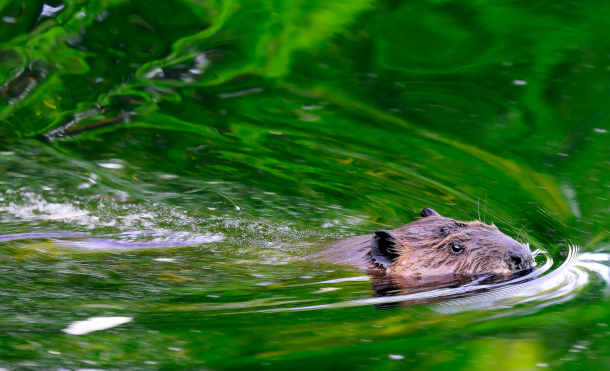
Beavers are moving north at an impressive rate, changing the Arctic landscape with their expansive impoundments. (Photo: Mark Guiliucci, Flickr, CC BY-NC 2.0)
DOERING: The Arctic is thought to be warming faster than any other region on earth, and that’s creating new habitat for grizzly bears, moose, salmon, wolves, and beavers. And as nature’s “ecosystem engineers” beavers are bringing big changes to the Arctic landscape. Ben Goldfarb is an environmental journalist and author of the book Eager: The Surprising, Secret Life of Beavers and Why They Matter. He says the tenacious rodents are making themselves right at home in the Arctic.
GOLDFARB: Yeah, so beavers are colonizing or perhaps recolonizing the Arctic at a pretty impressive rate. The guy who studied this the closest is an ecologist named Ken Tape in Alaska. And basically what he found by looking at satellite images--because beaver complexes are actually so large and impressive you can see them in satellite imagery--is that between 1999 and 2014, beavers built 56 new complexes of ponds in this area in the Arctic that Tape studied. And beavers were actually moving north by about eight kilometers, so five miles or so, per year. So they're moving north at a really impressive rate. The why is basically because the climate is changing, and the habitat is becoming suitable for them, right? Beavers need trees. And as the willow line advances north into the previously treeless tundra, it's creating this available food and building material for them, this resource that beavers need. A big question is whether this is really a new colonization, or whether they're really recolonizing areas where they used to live, before they were trapped out by fur traders. So certainly they're moving north. Whether that's a novel colonization event or a recolonization is still to be determined.
DOERING: Right, because I remember when we talked about your book, Eager, you said that there were hundreds of millions of beavers all over North America. And they're now recovering, right? What do we know right now about how many beavers there are at this point?
GOLDFARB: Yeah, we don't have a great beaver population estimate for North America, you know, states or provinces really keep good track. But the best guess we have is something like 10 to 15 million beavers on this continent, which, you know, sounds like a lot, right? They're not an endangered species, certainly. But as you pointed out, you know, that's a tiny fraction of the beavers that used to live on this continent historically, you know, we know that pre-European arrival, there were as many as 400 million beavers on this continent. So this was once a truly prolific, ubiquitous animal.
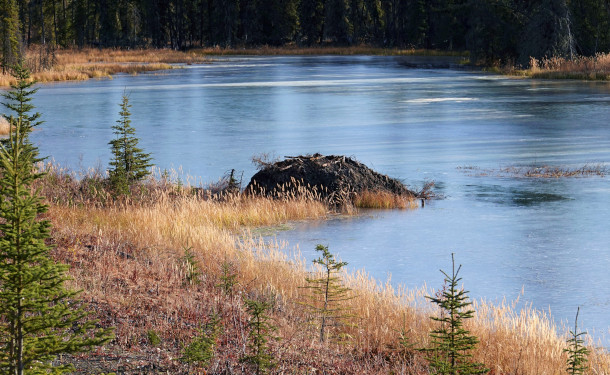
Beaver complexes can bring surprising benefits to any landscape, such as fostering habitats for a variety of other species. (Photo: JLS Photography-Alaska, Flickr, CC BY-NC-ND 2.0)
DOERING: So beavers are, of course, nature's engineers or ecosystem engineers. So on a physical level, how are beaver dams and ponds changing the Arctic tundra?
GOLDFARB: Yeah, I mean, certainly, as beavers build dams, they create these giant impoundments, right, these really impressive ponds, which can be many, many times the size of your typical Olympic swimming pool. And they're turning these historically kind of single-threaded channels and making them these big complexes of ponds and wetlands. And the big concern that some people have about that is that as a result, beavers may be melting the permafrost. There is lots of methane locked up in that permafrost. So as beavers spread water out, they may be releasing a very potent greenhouse gas into the atmosphere. But of course, beavers' contribution to climate change will always be a minuscule fraction of humans' contribution. So they're certainly not the ones to blame for this problem. And in fact I'd also point out that, you know, beavers are also fantastic sequesters of carbon, right, that you know, that a beaver colony, a beaver pond is full of all kinds of organic, carbon rich material. And there have been fantastic studies showing that beavers are locking up lots of carbon. So while it's true that in the Arctic, they may be releasing methane, elsewhere in their range, you know, they're keeping a lot of carbon out of the atmosphere.
DOERING: Ben, I know that one of the reasons that beavers are such an attractive animal to bring back in certain places, especially in the very arid American West is because their ponds lock up large amounts of water on the landscape and help revegetate and add moisture to a landscape that's drying out because of climate change. What are the potential benefits that they could bring to the Arctic?
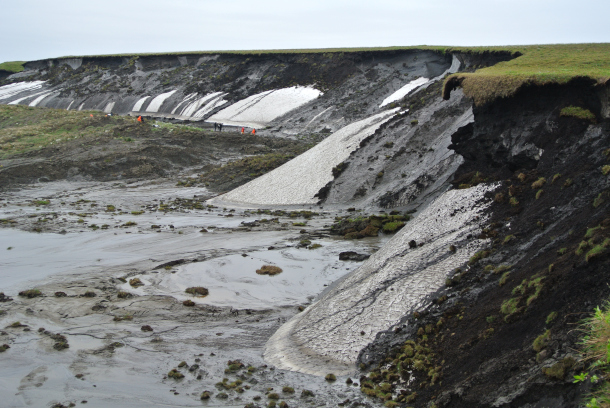
The frozen ground called permafrost is thawing as the Arctic warms, and scientists think beaver ponds may speed up that process, releasing the greenhouse gas methane. However, beaver ponds also help store carbon in landscapes, especially in lower latitudes. (Photo: Boris Radosavljevic, Wikimedia Commons, CC BY 2.0)
GOLDFARB: Yeah, you know, I've been interested in the way that some of these studies have been covered by the media, that the kind of the default assumption is that because beavers are moving to the Arctic, you know, yes, they're melting some permafrost, that must be a negative interaction. I remember a few years ago, the New York Times did a study where they called beavers "agents of Arctic destruction," as though beavers have done more to the Arctic than you know, than we humans have. And, you know, and to me, I mean, I think it's really important to remember that beavers are just these amazing keystone species, right? They're these animals that disproportionately support a lot of life wherever they are. I mean, because they create these wonderful pond and wetland complexes, you know, they just engineer fabulous habitat for all kinds of creatures, you know, trout and salmon, amphibians, waterfowl, songbirds, you know, other aquatic mammals like otters and mink and muskrat and moose. You know, you name it, you know, there's just this amazing body of literature about how important beavers are for other organisms. So I think that it's really important to just keep in mind that you know, some of the changes that beavers are inducing in the Arctic may be beneficial for some species, you know that okay, perhaps the melting of the permafrost is negative, but beavers are also to engineering habitat for animals that we know are moving north anyway, right? They're sort of paving the way for some of these creatures. So instead of "agents of Arctic destruction," you know, they're "agents of Arctic adaptation," at least for some organisms, I think.
DOERING: That's right, I mean, beavers are certainly not the only species shifting towards the poles as climate change happens. So how should we be thinking about which species, quote unquote, "belong" where in this new and evolving reality?
GOLDFARB: Yeah, it's a really interesting, philosophical question, I think. I mean, are animals that move north because of our actions in warming the climate, are those invasive species? I would argue not. They're animals that are just sort of resourcefully adapting to the conditions that we've created for them. We know that salmon, for example, you know, salmon are basically disappearing, in a lot of California, their native range there, but they're also salmon showing up in in new rivers in the Arctic, where they haven't been seen before. And we know that beavers create fantastic salmon habitat, you know, that baby salmon love to rear, to grow up, in the slow water refuges that beavers create. So I think that, you know, as I mentioned earlier, I think that for salmon and some other species, beavers could be doing potentially, at some point, a lot of good.
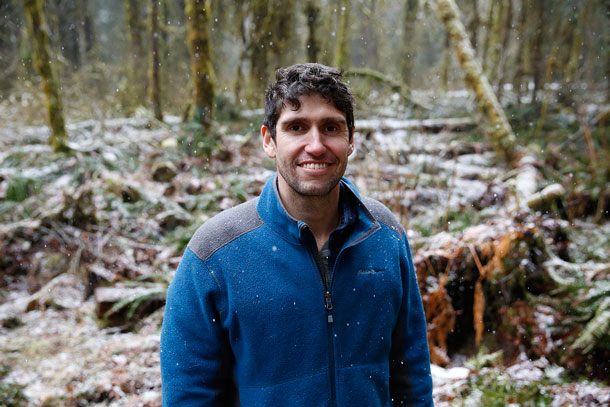
Ben Goldfarb is an environmental journalist, editor, and Beaver Believer. (Photo: Terray Sylvester)
DOERING: You know, beavers, as we know, they can cause some problems for communities when they first move in, maybe recolonize an area. They do cut down trees, and they do flood areas. Can you give us an example of how communities in the American West, for example, ranchers, were able to gradually switch to a "pro-beaver" mindset and sort of see some of the benefits of these engineers?
GOLDFARB: Yeah, it's a really good question. I mean, certainly beavers are not the easiest animals to live with. Right? There are all kinds of impacts to human infrastructure that beavers cause. As a result, there's this very long history of beaver persecution, right? First, we killed them for their pelts. And then as they started to recover in the 20th century, we killed them for having the temerity to mess with our stuff. And there are lots and lots of ranchers out there who I've talked to who told me, "Yeah, you know, yeah, my dad killed beavers, and his dad killed beavers, and his dad killed beavers for damming and irrigation ditches or you know, or road culverts or what have you. But, as the climate gets hotter and drier, and it becomes more and more important to keep water on the landscape, I think lots of farmers and ranchers are recognizing the benefits of having these animals around. Beavers are basically agents of water storage and water creation in a sense, you know, they create these wonderful watering holes and they're also irrigators, right? They spread water out, they force water into the ground. So they're, you know, when you look at a beaver pond, you know, you see all of that visible surface water, but you don't necessarily see the water table rising, the aquifers being recharged, the soil being hydrated. So there's lots of literature about beavers basically being irrigators, being plant producers, and if you're a rancher, you know with your cows in a valley with beavers in it, you know, you're going to have more forage for your cattle, you know, the beavers are just making the land lusher. So certainly, a lot of ranchers have appreciated that benefit.
DOERING: That’s Ben Goldfarb, environmental journalist and author of Eager: The Surprising, Secret Life of Beavers and Why They Matter, speaking with Living on Earth’s Jenni Doering.
Related links:
- Living on Earth | “Eager: The Surprising Secret Life of Beavers”
- Living on Earth | “How Beavers Help Save Water”
- Ben Goldfarb’s website
- NOAA | “Beaver Engineering: Tracking A New Disturbance In The Arctic”
- The Guardian | “Dam It: Beavers Head North to The Arctic as Tundra Continues to Heat Up”
- NPR | “Beavers Have Been Moving Into The Arctic, Accelerating The Effects Of Climate Change”
[MUSIC: Paula Fuga, “Nose Flute Dub” on Lilikoi, by Paula Fuga, Pakipalka Productions]
DOERING: To get the stories behind the stories at Living on Earth as well as special updates please sign up to the Living on Earth newsletter. Every week you’ll find out about upcoming events including show highlights and news updates. Just navigate to the living on earth website loe.org and click on the newsletter at the top of the page. That’s L O E dot ORG.
Coming up – the life and love of Wolf 21, one of Yellowstone National Park’s most famous resident wolves.
That’s just ahead on Living on Earth.
ANNOUNCER: Funding for Living on Earth comes from you, our listeners, and United Technologies, combining a passion for science with engineering to create solutions designed for sustainability in aerospace, building industries, and food refrigeration.
[MUSIC: Network Music Ensemble, “We Gather Together” on Jazz Hymns, by Adriaen Valerius/Eduard Kremser, Network Music]
The Reign of Wolf 21
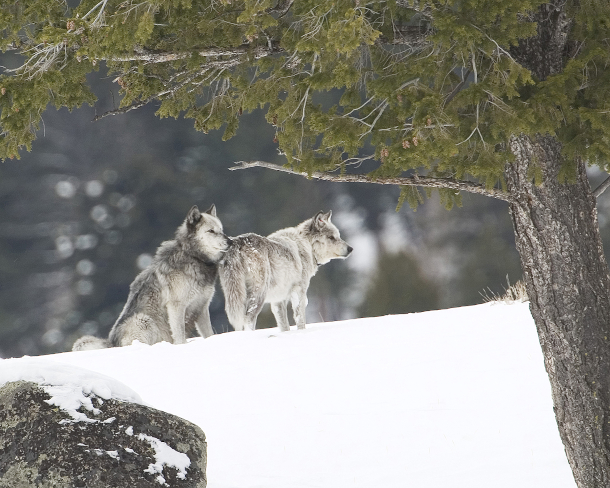
Wolf 21 and Wolf 42 on their last day together. They were nearly nine years old, twice the average life-span of Yellowstone wolves. (Photo: Kim Kaiser)
CURWOOD: It’s Living on Earth I’m Steve Curwood.
DOERING: And I’m Jenni Doering.
One of the most endearing aspects of dogs as pets is they can respond to each other and us humans with what seems to be unconditional love. So we shouldn’t be surprised by a love story about two wolves, given that wolves and dogs have almost identical DNA. I learned the wolf love story you are about to hear from Rick McIntyre who logged more than 100,000 wolf sightings in Yellowstone National Park as a biological technician with the Yellowstone Wolf Project. Rick’s longest continuous streak of watching the wolves starting in June 2000 was an incredible six thousand, one hundred seventy-five days. Wolves are most active at dusk and dawn, so Rick had lot of early mornings and late nights. And cold, sometimes the temperature got as low as 33 below! Rick McIntyre is retired now but he still gets out into the field almost every morning to watch the wolves, before coming home to write about them. I spoke with him about his 2020 book “The Reign of Wolf 21” which is the heartfelt account of 21 and his mate 42, and the Druid wolf pack they led for a decade in Yellowstone National Park.
[Paul Winter, “Wolf Eyes” on Common Ground, A&M Records]
DOERING: When Rick McIntyre is out tracking wolves, he peers down a powerful spotting scope to see them as far as a mile away. And shares the view with visitors.
MCINTYRE: A lot of folks visit Yellowstone; they all want to see wolves, so folks like myself, we get to help people have an experience with that. I’ve shown famous people wolves, movie stars; politicians; I’ve shown regular people, I’ve shown schoolkids…
DOERING: And he does a lot of his wolf watching in the Lamar Valley as its wide, flat meadows attract large herds of elk, pronghorn, and bison.
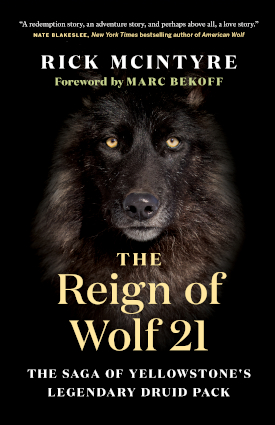
The Reign of Wolf 21 is part of Rick McIntyre’s “Alpha Wolves of Yellowstone” series. (Image: courtesy of Greystone Books)
[SOUNDS OF BISON GRAZING IN LAMAR VALLEY]
DOERING: Several creeks feed the Lamar River braiding its way beneath the snow-capped Absarokas. It’s a big, open landscape where humans can feel like there’s so much beyond us.
MCINTYRE: I think we understand now that we’re just part of a very big world and many other species are out there, including primates, and wolves, dolphins, whales, etc that have emotions and intelligence that are very very similar to us. Anyone that watches wolves in the wild, there’s just no way around it that they have very strong emotional aspects of their lives; they’re rational thinkers; they make decisions, whether good or bad.
DOERING: And they’re highly social animals who live together in packs of five to ten members. And Rick says packs can briefly grow to 30 or more members before some strike out on their own, living life as a lone wolf before finding another home.
[WOLF CALLS]
DOERING: And he told me he had to write a book about the alpha male that researchers called Wolf 21.
MCINTYRE: Well, there’s so much to say about him, it's almost like if Superman was a real person, how could you describe him?
[Paul Winter, “Wolf Eyes” on Common Ground, A&M Records]
DOERING: This hero had mostly grey fur, with a cape of black along his back. He not only survived in the harsh Yellowstone climate… As the alpha male of the powerful Druid Peak Pack, Wolf 21 thrived.
MCINTYRE: So from his biological father who he never knew, 21 was gifted with extremely superior genetics. So he grew up into a very large, a very strong wolf.
DOERING: Which matters a lot when it’s your responsibility to bring down elk and even bison. And to protect your family from rival packs. The Yellowstone ecosystem supports about 8 to 10 packs with names like Leopold, Chief Joseph and Mollie’s, which each patrol their own territory. They often overlap, and conflicts are common. In fact, wolves in Yellowstone are most likely to die from wounds inflicted by other wolves. But Wolf 21 didn’t have to worry too much about that.
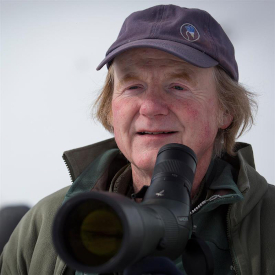
Rick McIntyre with his powerful spotting scope, which he uses to help him see wolves as far as a mile away. (Photo: Julie Argyle)
MCINTYRE: As far as we know, he never lost a fight in his life, including times where he had to fight several other males at the same time, so he was the undisputed undefeated heavyweight champion of Yellowstone.
DOERING: And, despite the fact that wolf fights can be brutal…
MCINTYRE: He never killed a defeated opponent.
DOERING: He’d beat up rival wolves, sure. Fearlessly defend his kin. He let rival packs know whose land they were on, the mighty Druids. But then he’d step back and let them go.
[Paul Winter, “Wolf Eyes” on Common Ground, A&M Records]
MCINTYRE: He was, um… I think many people would agree that he was probably the greatest wolf that has ever been known by a human being, so just to be able to see him every day for year after year was just a huge privilege on my part. I saw him deal with all sorts of problems and crises, and he just had this very smooth way of mainly using nonviolence when he could, or minimum violence and force when necessary. Oftentimes I would compare him to people who had very special dogs in their life, that were so loyal and devoted and had such good characters, and I think you know that all modern dogs in the world come directly from wolf ancestors, so everything we admire in our pet dogs, their courage, their bravery, their loyalty, their devotion, their playfulness, all that, that comes exactly from ancestors like Wolf 21.
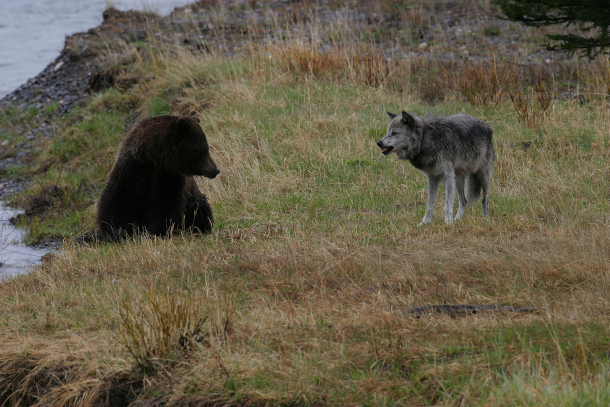
Wolf 21 confronts a grizzly bear eyeing an elk the alpha wolf had just killed. (Photo: Betsy Downey)
[Paul Winter, “Wolf Eyes” on Common Ground, A&M Records]
DOERING: Alongside the alpha female, he led one of the largest packs in Yellowstone history, with 37 wolves at its height. The Druid Pack drew the fervent attention of the wolf watching public. They’d flock in the hundreds to the Lamar Valley where they reigned. Rick would help them find the pack, and if they were lucky and patient, these adoring Yellowstone visitors would get to see the alphas leading a hunt or chowing down on a carcass… or playing with their pups.
[SOUNDS OF WOLF PUPS PLAYING AND ADULT GROWLING]
MCINTYRE: You would see this gigantic male wolf start a wrestling match with a little tiny pup, let’s say, maybe a month or two old.
[WOLF PUP PLAYING SFX]
MCINTYRE: And it seemed like 21 would wait for the pup to grab one of 21’s legs or maybe a piece of fur on his belly or something like that. And with the most gentle tug that probably the pup was making, 21 would flop over on his back, pretending that the little pup had just defeated him in battle. It was just another aspect of his personality that was so fascinating to watch.
DOERING: The alpha male Wolf 21 was beloved by the public and it’s no surprise he’s the focus of Rick’s book. But Rick says the alpha female plays just as important of a role, if not more so, in leading the pack. And at one point in the Druid Peak Pack, the alpha female known as Wolf 40 had a leadership style that, well let’s just say it was very different from Wolf 21’s peaceful demeanor.
[SOUNDS OF WOLF SNARLS, GROWLS, YELPS]
DOERING: Competition within packs is normal; after all – the alphas have the best chance of passing on their genes, and there can only be one alpha male, and one alpha female. And sometimes, she’ll do anything to gain power.
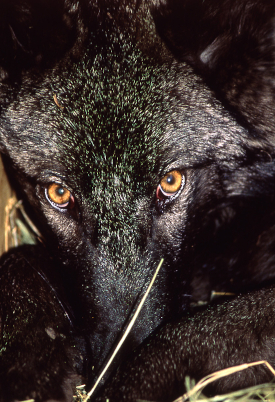
Wolf 21 at 5 months old. His pack was relocated to an acclimation pen after the alpha male, 21’s father, was shot and killed just outside of the Yellowstone National Park boundary. (Photo: NPS / Barry O’Neill)
MCINTYRE: We don't know exactly what 40’s problem was, but she had a very violent and aggressive personality. She drove her own mother out of the pack, and then one of her two sisters, so that she was now the alpha female.
DOERING: For years, she relentlessly bullied and abused her remaining sister, who didn’t seem to be able to fight back.
[SOUNDS OF WOLF SNARLS, GROWLS, YELPS]
DOERING: She’d bite and beat up “Cinderella”, which is what the Wolf Project researchers nicknamed the underdog. There were signs that the old alpha even killed her sister’s pups two years in a row, in 1998 and ‘99. A wolf pack can only feed so many hungry mouths, so this kind of behavior isn’t unusual, though it sounds cruel. And the big, powerful Wolf 21?...
MCINTYRE: Male wolves in the wild seem to have a compunction against doing anything that will harm a female.
DOERING: … He could only stand helplessly aside as the aggressive female attacked their pack. Then, in 2000, something happened that changed his destiny and the fate of the Druid Peak Pack. The wolves ended up having four litters that spring. That meant a lot of hungry mouths to feed. And “Cinderella” had her pups in a den a few miles away from her abusive sister. One night in May, the alpha female, Wolf 40, decided she didn’t want to put up with competition from her sister 42’s young pups.
[SOUNDS OF WOLF SNARLS, GROWLS, YELPS]
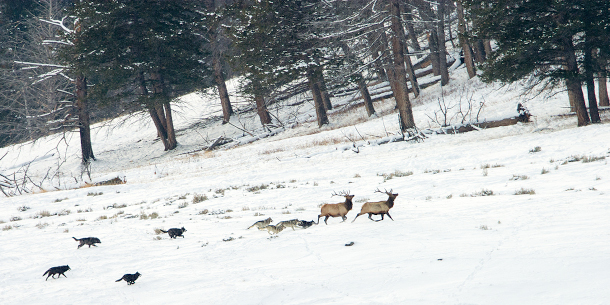
The Druid Peak Pack chasing bull elk in Yellowstone. (Photo: Doug Dance)
MCINTYRE: As far as we can tell, for the first time in her life, 42 actually stood up to her sister. She had to, to protect her pups, and in a fight with her sister 42 could not win, she just did not have the killer instinct.
DOERING: But some younger females in the pack had been bullied too, and they came to her aid.
MCINTYRE: So when I came out early the next morning, I found wolf 40 lying next to the road just drenched in blood, covered with wolf bites. And she died of blood loss just a short time after that. So all those years of abuse that 42 had suffered from her sister, it culminated that night.
[SOUNDS OF GROUP HOWLS]
DOERING: And “Cinderella” became the new alpha female of the Druid Peak Pack.
[GROUP HOWLS]
DOERING: Now she and Wolf 21 reigned over the grand Lamar Valley.
[Paul Winter, “Wolf Eyes” on Common Ground, A&M Records]
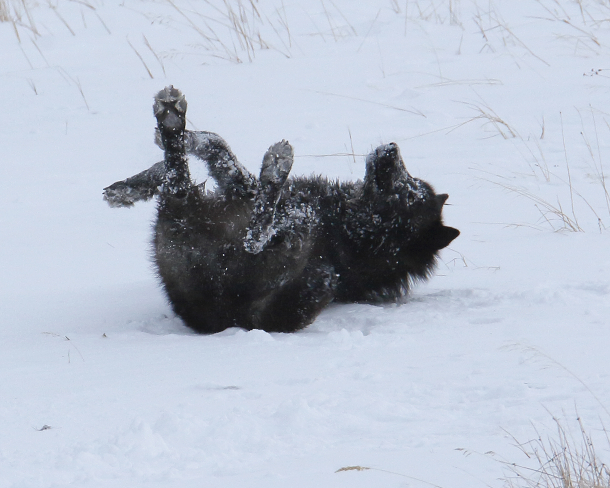
A Druid pup scratches its back by rolling on the snow. (Photo: Bob Weselmann)
DOERING: They had a strong pair bond and seemed meant for each other, Rick says.
MCINTYRE: It really was a special thing. They spent at least two thirds of their life together. They were devoted to each other.
[Paul Winter, “Wolf Eyes” on Common Ground, A&M Records]
DOERING: It was a bond that knit them tighter together with time.
MCINTYRE: They were both born with jet-black fur, and as sometimes happens with married couples that are together for decades and decades, as they grew old they looked even more and more like each other, so they started to turn grey about the same pattern.
[Paul Winter, “Wolf Eyes” on Common Ground, A&M Records]
DOERING: Every morning, Rick rose at 3:30 or so to get out in the field and watch their lives unfold. To see what he could learn from the behavior of the alpha male and the many litters he raised with 42.
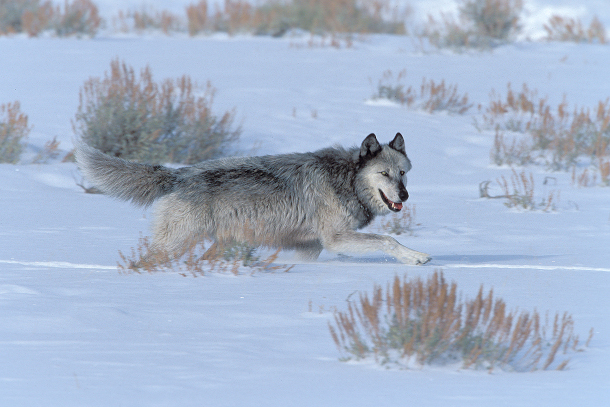
Wolf 21 at age eight with a lot of gray on his black coat. (Photo: Doug Dance)
MCINTYRE: He was so dedicated to his family, to his friends, he would do anything for them. Certainly, risk his life constantly for them.
DOERING: Even provide emotional support.
MCINTYRE: Especially with the younger wolves in his family. There was a time where he noticed that one of his young sons was being bullied by the other yearlings, and 21 went out of his way to go to that one particular yearling and give him special attention in front of the other young males.
DOERING: And if you’re a young wolf in a pack and the alpha male comes over to you –
MCINTYRE: -- and gives you special attention like he approves of you, that’s a pretty big deal.
[Paul Winter, “Wolf Eyes” on Common Ground, A&M Records]
DOERING: Rick says this kindness and empathy made Wolf 21 stand out.
MCINTYRE: He certainly was an ideal role model for me, and for everyone else that knew him. If all of us could be more like 21, or like 42, the world would be a lot better place.
[Paul Winter, “Wolf Eyes” on Common Ground, A&M Records]
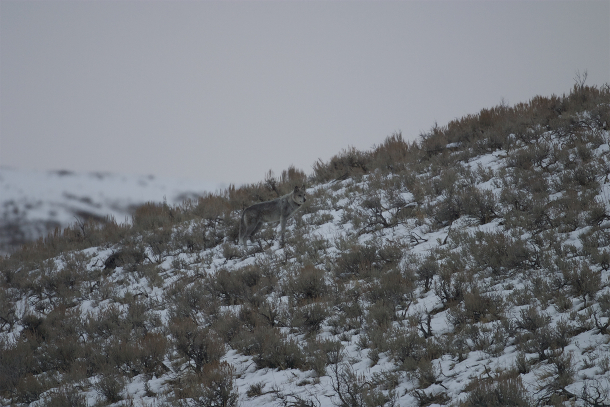
Alpha female Wolf 42, longtime mate to 21, when she was eight years old. (Photo: Steven Hargreaves)
MCINTYRE: So this one particular day in late January I saw the two of them come together, it was just the start of the mating season, and they were very affectionate with each other and from a distance of about a mile or two away, I saw them have a mating.
It was very touching, because they laid down as they were still mating, and he put one of his paws around her shoulder in a very affectionate way.
[Paul Winter, “Wolf Eyes” on Common Ground, A&M Records]
DOERING: The next morning Rick got up as usual hours before sunrise and soon spotted the family. He could see the patriarch. But where was his mate?
He couldn’t get a signal from her radio collar.
“Cinderella” was missing.
Rick and his colleagues started searching for her.
MCINTYRE: We found out what happened to her that night.
DOERING: The wolf project tracking plane circled over where it looked like there had been a big fight. The alpha female lay still in the snow, the latest victim of a wolf battle, with the rival Mollie’s Pack.
MCINTYRE: But 21 did not know.
[SOUNDS OF MOURNFUL WOLF HOWL]
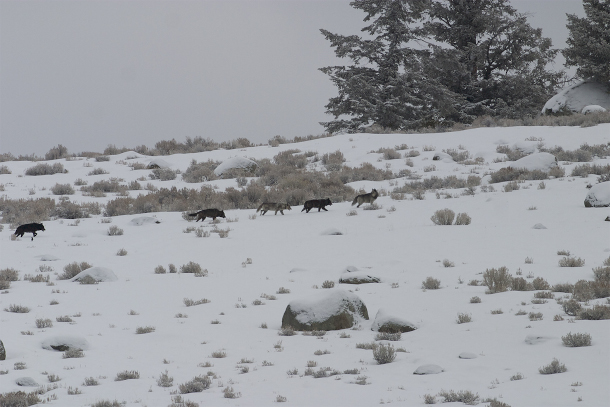
The Druid pack (Photo: Steven Hargreaves)
DOERING: He spent the next two months going in a search pattern throughout his territory, as far as I could tell, acting like he was trying to find her. And he never did.
[SOUNDS OF HOWLS AND WIND]
MCINTYRE: And I could see that he was rapidly experiencing a physical decline. He was turning gray at a much faster rate than he had just a short time before that. He seemed to be listless. He just wasn't the same as he had been prior to that time.
DOERING: Before long, 4 months had passed since she had gone missing. It was June now, nearly the longest day of the year. Rick was up early as usual, watching the pack.
MCINTYRE: And some of the younger adults in the family had a few elk come into their meadow.
DOERING: The young Druids eagerly gave chase, but…
MCINTYRE: I looked over at 21, and he just was lying there, he just had no energy left to join in that hunt. And that was the moment that I realized that this was really about it for 21, that this was so unlike him. And that was the last time I saw him.
DOERING: A month passed with no sign of what had happened to the old alpha male. Then, in mid-July, a grim discovery. An outfitter found wolf remains with a radio collar that had long since stopped working. Rick and a pack of other Wolf Project and park employees rode on horseback up to the meadow where he had been found.
DOERING: It had been a special rendezvous site for the Druid Alphas, a place to meet up.
[Paul Winter, “Wolf Eyes” on Common Ground, A&M Records]
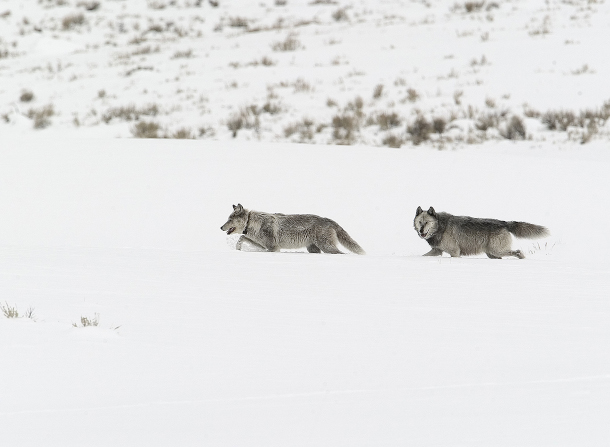
Wolf 21 and 42 on the move, on their last day together (Photo: Kim Kaiser))
MCINTYRE: He decided to go one last place, way up in the mountains. One last place where there might be a chance of finding 42.
DOERING: She wasn’t there, but a tree they’d marked together many times might have held a trace of her scent. He’d curled up and gone to sleep one last time in the shade of that tree, maybe dreaming of his long-lost love.
[Paul Winter, “Wolf Eyes” on Common Ground, A&M Records]
DOERING: Rick McIntyre’s 2020 book is called The Reign of Wolf 21.
Related links:
- Find the book "The Reign of Wolf 21" (Affiliate link helps donate to LOE and local indie bookstores)
- Learn more about the Yellowstone Wolf Project
- Learn about wolf restoration in Yellowstone
- Listen to "Wolf Eyes" by Paul Winter
[Paul Winter, “Wolf Eyes” on Common Ground, A&M Records]
CURWOOD: Living on Earth is produced by the World Media Foundation.
Our crew includes Naomi Arenberg, Bobby Bascomb, Paloma Beltran, Chloe Chen, Iris Chen, Josh Croom, Delaney Dryfoos, Mark Kausch, Mark Seth Lender, Don Lyman, Louis Mallison, Aynsley O’Neill, Sophia Pandelidis, Jake Rego, Hannah Richter, and Jolanda Omari.
DOERING: Tom Tiger engineered our show. Alison Lirish Dean composed our themes. Special thanks this week to Destination Wildlife.
You can hear us anytime at L-O-E dot org, Apple Podcasts and Google Podcasts, and like us, please, on our Facebook page - Living on Earth.
we tweet from @livingonearth. And find us on Instagram at livingonearthradio.
DOERING: I’m Jenni Doering
CURWOOD: Thanks for listening!
ANNOUNCER: Funding for Living on Earth comes from you, our listeners, and from the University of Massachusetts, Boston, in association with its School for the Environment, developing the next generation of environmental leaders. And from the Grantham Foundation for the protection of the environment, supporting strategic communications and collaboration in solving the world’s most pressing environmental problems.
Living on Earth wants to hear from you!
Living on Earth
62 Calef Highway, Suite 212
Lee, NH 03861
Telephone: 617-287-4121
E-mail: comments@loe.org
Newsletter [Click here]
Donate to Living on Earth!
Living on Earth is an independent media program and relies entirely on contributions from listeners and institutions supporting public service. Please donate now to preserve an independent environmental voice.
NewsletterLiving on Earth offers a weekly delivery of the show's rundown to your mailbox. Sign up for our newsletter today!
 Sailors For The Sea: Be the change you want to sea.
Sailors For The Sea: Be the change you want to sea.
 The Grantham Foundation for the Protection of the Environment: Committed to protecting and improving the health of the global environment.
The Grantham Foundation for the Protection of the Environment: Committed to protecting and improving the health of the global environment.
 Contribute to Living on Earth and receive, as our gift to you, an archival print of one of Mark Seth Lender's extraordinary wildlife photographs. Follow the link to see Mark's current collection of photographs.
Contribute to Living on Earth and receive, as our gift to you, an archival print of one of Mark Seth Lender's extraordinary wildlife photographs. Follow the link to see Mark's current collection of photographs.
 Buy a signed copy of Mark Seth Lender's book Smeagull the Seagull & support Living on Earth
Buy a signed copy of Mark Seth Lender's book Smeagull the Seagull & support Living on Earth

